Hydrological Response to ~30 years of Agricultural Surface Water Management
Abstract
:1. Introduction
2. Materials and Methods
2.1. Study Area
2.2. Changes in the Agricultural System
2.3. Network Extraction for 1983 and 2010
2.4. Updated Network Saturation Index (uNSI)
- it includes infiltration according to the Green and Ampt [43] approach;
- the NSI is evaluated as localised value over each user-defined subarea.
- Obtain annual maximum series of precipitation depth for a given duration (1, 3, 6, 12 and 24 h) [45];
- Use the Gumbel [46] distribution to find the precipitation depths for different return periods (2, 5, 10, 30, 50, 100 and 200 years);
- Plot depth versus duration for various frequencies and derive the DDF curves in the form
2.5. Statistical Influence of Climate on Ponding Time and uNSI
- the percentage of the total storm period that has occurred at the start of the heaviest burst (BrLoc%);
- the number of bursts (Brn);
- the shape of the hyetograph defined as its “triangularity” (TRN). To this point, the triangularity is the ratio between the hyetograph area and the area of a triangle having as base the hyetograph duration, and as height, the height of the main rainfall burst. Values close to 1 would represent highly triangular hyetographs (e.g., Sym02 to Sym04), with rainfall having regular intensity, whereas values close to 0 would represent hyetographs whose peaks is an abrupt change in intensity (e.g., Sym10 to Sym17);
- the asymmetry of the storm volumes (asym), defined as the ratio between the amount of rainfall fell before the maximum burst and that after the burst. Values higher than 1 imply that the rainfall amount before the burst was greater than that after the burst; values close to 1 imply a symmetry of the rainfall volumes; values smaller than 1 imply that the rainfall volume after the burst is higher than that before.
3. Results
3.1. Changes in the Agricultural System and Consequent Changes in Surface Water Management
3.2. Ponding Time
3.3. Changes in Water Storage and uNSI
3.4. Statistical Influence of Climate on Ponding Time and uNSI
4. Discussion
5. Conclusions
Supplementary Materials
Acknowledgments
Author Contributions
Conflicts of Interest
References
- Tarolli, P.; Sofia, G. Human topographic signatures and derived geomorphic processes across landscapes. Geomorphology 2016, 255, 140–161. [Google Scholar] [CrossRef]
- Tarolli, P. Humans and the Earth’s surface. Earth Surf. Process. Landf. 2016, 41, 2301–2304. [Google Scholar] [CrossRef]
- Niehoff, D.; Fritsch, U.; Bronstert, A. Land-use impacts on storm-runoff generation: Scenarios of land-use change and simulation of hydrological response in a meso-scale catchment in SW-Germany. J. Hydrol. 2002, 267, 80–93. [Google Scholar] [CrossRef]
- Sofia, G.; Roder, G.; Dalla Fontana, G.; Tarolli, P. Flood dynamics in urbanised landscapes: 100 years of climate and humans’ interaction. Sci. Rep. 2017, 7. [Google Scholar] [CrossRef]
- Comino, J.R.; Quiquerez, A.; Follain, S.; Raclot, D.; Bissonnais, Y.L.; Casalí, J.; Giménez, R.; Cerdà, A.; Keesstra, S.D.; Brevik, E.C.; et al. Soil erosion in sloping vineyards assessed by using botanical indicators and sediment collectors in the Ruwer-Mosel valley. Agric. Ecosyst. Environ. 2016, 233, 158–170. [Google Scholar] [CrossRef]
- Comino, J.R.; Iserloh, T.; Morvan, X.; Malam Issa, O.; Naisse, C.; Keesstra, S.; Cerdà, A.; Prosdocimi, M.; Arnáez, J.; Lasanta, T.; et al. Soil erosion processes in European vineyards: A qualitative comparison of rainfall simulation measurements in Germany, Spain and France. Hydrology 2016, 3. [Google Scholar] [CrossRef]
- Prosdocimi, M.; Cerdà, A.; Tarolli, P. Soil water erosion on Mediterranean vineyards: A review. CATENA 2016, 141, 1–21. [Google Scholar] [CrossRef]
- Di Stefano, C.; Ferro, V.; Burguet, M.; Taguas, E.V. Testing the long term applicability of USLE-M equation at a olive orchard microcatchment in Spain. CATENA 2016, 147, 71–79. [Google Scholar] [CrossRef]
- Taguas, E.V.; Yuan, Y.; Licciardello, F.; Gómez, J.A. Curve numbers for olive orchard catchments: Case study in southern Spain. J. Irrig. Drain. Eng. 2015, 141. [Google Scholar] [CrossRef]
- Imeson, A.C.; Lavee, H. Soil erosion and climate change: The transect approach and the influence of scale. Geomorphology 1998, 23, 219–227. [Google Scholar] [CrossRef]
- Sinoga, J.D.R.; Murillo, J.F.M. Effects of soil surface components on soil hydrological behaviour in a dry Mediterranean environment (southern Spain). Geomorphology 2009, 108, 234–245. [Google Scholar] [CrossRef]
- Cerdà, A. Relationships between climate and soil hydrological and erosional characteristics along climatic gradients in Mediterranean limestone areas. Geomorphology 1998, 25, 123–134. [Google Scholar] [CrossRef]
- Earle, T.; Doyle, D. The engineered landscapes of irrigation. In Economies and Transformation of Landscape; Cliggett, L., Pool, C.A., Eds.; Altamira Press: Lanham, MD, USA, 2008; pp. 19–46. [Google Scholar]
- Lewin, J. The English floodplain. Geogr. J. 2014, 180, 317–325. [Google Scholar] [CrossRef]
- Sofia, G.; Prosdocimi, M.; Fontana, G.D.; Tarolli, P. Modification of artificial drainage networks during the past half-century: Evidence and effects in a reclamation area in the Veneto floodplain (Italy). Anthropocene 2014, 6, 48–62. [Google Scholar] [CrossRef]
- Sofia, G.; Masin, R.; Tarolli, P. Prospects for crowdsourced information on the geomorphic “engineering” by the invasive Coypu (Myocastor coypus). Earth Surf. Process. Landf. 2017. [Google Scholar] [CrossRef]
- Schultz, B. Irrigation, drainage and flood protection in a rapidly changing world. Irrig. Drain. 2001, 50, 261–277. [Google Scholar] [CrossRef]
- Pistocchi, A.; Calzolari, C.; Malucelli, F.; Ungaro, F. Soil sealing and flood risks in the plains of Emilia-Romagna, Italy. J. Hydrol. Reg. Stud. 2015, 4, 398–409. [Google Scholar] [CrossRef]
- Nature. Archaeology: Early farmers caused floods. Nature 2011, 471. [Google Scholar] [CrossRef]
- Stinchcomb, G.E.; Messner, T.C.; Driese, S.G.; Nordt, L.C.; Stewart, R.M. Pre-colonial (A.D. 1100–1600) sedimentation related to prehistoric maize agriculture and climate change in eastern North America. Geology 2011, 39, 363–366. [Google Scholar] [CrossRef]
- Howgate, O.R.; Kenyon, W. Community cooperation with natural flood management: A case study in the Scottish Borders. Area 2009, 41, 329–340. [Google Scholar] [CrossRef]
- Bisaro, A.; Hinkel, J. Governance of social dilemmas in climate change adaptation. Nat. Clim. Chang. 2016, 6, 354–359. [Google Scholar] [CrossRef]
- Posthumus, H.; Hewett, C.J.M.; Morris, J.; Quinn, P.F. Agricultural land use and flood risk management: Engaging with stakeholders in North Yorkshire. Agric. Water Manag. 2008, 95, 787–798. [Google Scholar] [CrossRef]
- Fabian, L. Extreme cities and isotropic territories: Scenarios and projects arising from the environmental emergency of the central Veneto città diffusa. Int. J. Disaster Risk Sci. 2012, 3, 11–22. [Google Scholar] [CrossRef]
- Mysiak, J.; Testella, F.; Bonaiuto, M.; Carrus, G.; de Dominicis, S.; Ganucci Cancellieri, U.; Firus, K.; Grifoni, P. Flood risk management in Italy: Challenges and opportunities for the implementation of the EU Floods Directive (2007/60/EC). Nat. Hazards Earth Syst. Sci. 2013, 13, 2883–2890. [Google Scholar] [CrossRef]
- Hankin, B.; Waller, S.; Astle, G.; Kellagher, R. Mapping space for water: Screening for urban flash flooding. J. Flood Risk Manag. 2008, 1, 13–22. [Google Scholar] [CrossRef]
- Piano di Assetto del Territorio (PAT). Piano di Assetto del Territorio del Comune di Galzignano Terme; Relazione di compatibilità idraulica: Padova, Itlay, 2012. [Google Scholar]
- Regione del Veneto. Database Delle Diverse Litologie che Compongono il Territorio Della Regione Veneto Scala 1:250,000. Available online: http://dati.veneto.it/dataset/database-delle-diverse-litologie-che-compongono-il-territorio-della-regione-veneto-scala-1-250000 (accessed on 28 December 2016).
- Nasri, B.; Fouché, O.; Torri, D. Coupling published pedotransfer functions for the estimation of bulk density and saturated hydraulic conductivity in stony soils. CATENA 2015, 131, 99–108. [Google Scholar] [CrossRef]
- Agenzia regionale per la prevenzione e protezione ambientale del Veneto. Valutazione della permeabilità e del gruppo idrologico dei suoli del Veneto. ARPAV-Servizio Regionale Suoli 2011, 1–19. [Google Scholar]
- Ungaro, F.; Calzolari, C.; Busoni, E. Development of pedotransfer functions using a group method of data handling for the soil of the Pianura Padano–Veneta region of North Italy: Water retention properties. Geoderma 2005, 124, 293–317. [Google Scholar] [CrossRef]
- Saxton, K.E.; Rawls, W.J.; Romberger, J.S.; Papendick, R.I. Estimating generalized soil-water characteristics from texture 1. Soil Sci. Soc. Am. J. 1986, 50, 1031–1036. [Google Scholar] [CrossRef]
- Rawls, W.J.; Pachepsky, Y.A.; Ritchie, J.C.; Sobecki, T.M.; Bloodworth, H. Effect of soil organic carbon on soil water retention. Geoderma 2003, 116, 61–76. [Google Scholar] [CrossRef]
- Columba, P.; Altamore, L. Irrigazione e sviluppo agricolo: evoluzione dell’uso dell’acqua ed effetti sul valore del prodotto. Ital. J. Agron. 2006, 3, 452–454. [Google Scholar]
- Regione del Veneto. Lo Sviluppo Rurale in Veneto—Schede informative 2014; Regione del Veneto: Venice, Itlay, 2014. [Google Scholar]
- Direzione Sistema Statistico Regionale. Dati Sull’agricoltura; Regione del Veneto—Direzione Sistema Statistico Regionale: Venice, Itlay, 2011. [Google Scholar]
- Regione Veneto Statistical Report 2013, Chapter 7—The Agricultural Sector Amid Changes and Tradition. Available online: http://statistica.regione.veneto.it/ENG/Pubblicazioni/RapportoStatistico2013/Capitolo7.html (accessed on 28 December 2016).
- Irrigation: Number of Farms, Areas and Equipment by Size of Farm (UAA) and NUTS 2 Regions; Eurostat: Luxembourg, 2015.
- Consiglio Regionale del Veneto. Le Superfici Agricole in Veneto: Aggiornamento Statistico e Implicazioni Territoriali Dell’uso del Suolo; Consiglio Regionale del Veneto: Venice, Itlay, 2012. [Google Scholar]
- Zucaro, R.; Povellato, A.; Serino, G.; Ferraretto, D.; Rainato, R.; Papaleo, A.; Capone, S. Rapporto Sullo Stato Dell’Irrigazione in Veneto; Istituto Nazionale di Economia Agraria (INEA): Rome, Itlay, 2009. [Google Scholar]
- O’Connell, P.E.; Ewen, J.; O’Donnell, G.; Quinn, P. Is there a link between agricultural land-use management and flooding? Hydrol. Earth Syst. Sci. 2007, 11, 96–107. [Google Scholar] [CrossRef]
- Cazorzi, F.; Fontana, G.D.; de Luca, A.; Sofia, G.; Tarolli, P. Drainage network detection and assessment of network storage capacity in agrarian landscape. Hydrol. Process. 2013, 27, 541–553. [Google Scholar] [CrossRef]
- Green, H.W.; Ampt, G.A. Studies on soil phyics. J. Agric. Sci. 1911, 4, 1–24. [Google Scholar] [CrossRef]
- Svensson, C.; Jones, D.A. Review of rainfall frequency estimation methods. J. Flood Risk Manag. 2010, 3, 296–313. [Google Scholar] [CrossRef] [Green Version]
- Regione Veneto Commissioni Regionali. Caratterizzazione delle Pioggie Intense sul Bacino Scolante Nella Laguna di Venezia; Regione Veneto Commissioni Regionali: Venice, Itlay, 2003. [Google Scholar]
- Gumbel, E.J. Statistics of Extremes; Columbia University Press: New York, NY, USA, 1958. [Google Scholar]
- Wilson, B.N.; Sheshukov, A.; Pulley, R. Erosion Risk Assessment Tool For Construction Sites. Available online: http://hdl.handle.net/11299/625 (accessed on 28 December 2016).
- Florida Department of Transportation. Drainage Manual—IDF Curves and Rainfall Distributions; Florida Department of Transportation: Tallahassee, FL, USA, 2015.
- Cronshey, R. Urban Hydrology for Small Watersheds, 2nd ed.United States Department of Agriculture (USDA): Washington, DC, USA, 1986.
- Management and Storage of Surface Waters; St. Johns River Water Management District: Palatka, FL, USA, 2010.
- Salvucci, G.D.; Entekhabi, D. Explicit expressions for Green-Ampt (delta function diffusivity) infiltration rate and cumulative storage. Water Resour. Res. 1994, 30, 2661–2663. [Google Scholar] [CrossRef]
- Kale, R.V.; Sahoo, B. Green-Ampt infiltration models for varied field conditions: A revisit. Water Resour. Manag. 2011, 25, 3505–3536. [Google Scholar] [CrossRef]
- Risse, L.M.; Nearing, M.A.; Zhang, X.C. Variability in Green-Ampt effective hydraulic conductivity under fallow conditions. J. Hydrol. 1995, 169, 1–24. [Google Scholar] [CrossRef]
- Huff, F.A. Time distribution of rainfall in heavy storms. Water Resour. Res. 1967, 3, 1007–1019. [Google Scholar] [CrossRef]
- Abbs, D.J. A numerical modeling study to investigate the assumptions used in the calculation of probable maximum precipitation. Water Resour. Res. 1999, 35, 785–796. [Google Scholar] [CrossRef]
- Cortesi, N.; Gonzalez-Hidalgo, J.C.; Brunetti, M.; Martin-Vide, J. Daily precipitation concentration across Europe 1971–2010. Nat. Hazards Earth Syst. Sci. 2012, 12, 2799–2810. [Google Scholar] [CrossRef]
- Zhang, Q.; Xu, C.; Gemmer, M.; Chen, Y.D.; Liu, C. Changing properties of precipitation concentration in the Pearl River basin, China. Stoch. Environ. Res. Risk Assess. 2009, 23, 377–385. [Google Scholar] [CrossRef]
- Wasko, C.; Sharma, A. Steeper temporal distribution of rain intensity at higher temperatures within Australian storms. Nat. Geosci. 2015, 8, 527–529. [Google Scholar] [CrossRef]
- Cook, R.D. Influential observations in linear regression. J. Am. Stat. Assoc. 1979, 74, 169–174. [Google Scholar] [CrossRef]
- Durbin, J.; Watson, G.S. Testing for serial correlation in least squares regression. Biometrika 1950, 37, 409–428. [Google Scholar] [CrossRef] [PubMed]
- Italian National Institute of Statistics (ISTAT). Atlante Statistico dei Comuni; ISTAT: Rome, Itlay, 2014. [Google Scholar]
- Blann, K.L.; Anderson, J.L.; Sands, G.R.; Vondracek, B. Effects of agricultural drainage on aquatic ecosystems: A review. Crit. Rev. Environ. Sci. Technol. 2009, 39, 909–1001. [Google Scholar] [CrossRef]
- Schilling, K.E.; Helmers, M. Effects of subsurface drainage tiles on streamflow in Iowa agricultural watersheds: Exploratory hydrograph analysis. Hydrol. Process. 2008, 22, 4497–4506. [Google Scholar] [CrossRef]
- Schilling, K.E.; Jha, M.K.; Zhang, Y.K.; Gassman, P.W.; Wolter, C.F. Impact of land use and land cover change on the water balance of a large agricultural watershed: Historical effects and future directions. Water Resour. Res. 2008, 44. [Google Scholar] [CrossRef]
- Thiene, M.; Tsur, Y. Agricultural landscape value and irrigation water policy. J. Agric. Econ. 2013, 64, 641–653. [Google Scholar] [CrossRef]
- Kiss, T.; Benyhe, B. Micro-topographical surface alteration caused by tillage and irrigation canal maintenance and its consequences on excess water development. Soil Tillage Res. 2015, 148, 106–118. [Google Scholar] [CrossRef]
- Schottler, S.P.; Ulrich, J.; Belmont, P.; Moore, R.; Lauer, J.W.; Engstrom, D.R.; Almendinger, J.E. Twentieth century agricultural drainage creates more erosive rivers. Hydrol. Process. 2014, 28, 1951–1961. [Google Scholar] [CrossRef]
- Prosdocimi, M.; Tarolli, P.; Cerdà, A. Mulching practices for reducing soil water erosion: A review. Earth Sci. Rev. 2016, 161, 191–203. [Google Scholar] [CrossRef]
- Prosdocimi, M.; Burguet, M.; di Prima, S.; Sofia, G.; Terol, E.; Comino, J.R.; Cerdà, A.; Tarolli, P. Rainfall simulation and Structure-from-Motion photogrammetry for the analysis of soil water erosion in Mediterranean vineyards. Sci. Total Environ. 2017, 574, 204–215. [Google Scholar] [CrossRef] [PubMed]
- Bronstert, A.; Niehoff, D.; Bürger, G. Effects of climate and land-use change on storm runoff generation: Present knowledge and modelling capabilities. Hydrol. Process. 2002, 16, 509–529. [Google Scholar] [CrossRef]
- Krause, S.; Jacobs, J.; Bronstert, A. Modelling the impacts of land-use and drainage density on the water balance of a lowland–floodplain landscape in northeast Germany. Ecol. Modell. 2007, 200, 475–492. [Google Scholar] [CrossRef]
- Ungaro, F.; Calzolari, C.; Pistocchi, A.; Malucelli, F. Modelling the impact of increasing soil sealing on runoff coefficients at regional scale: A hydropedological approach. J. Hydrol. Hydromechanics 2014, 62, 33–42. [Google Scholar]
- Moussa, R.; Voltz, M.; Andrieux, P. Effects of the spatial organization of agricultural management on the hydrological behaviour of a farmed catchment during flood events. Hydrol. Process. 2002, 16, 393–412. [Google Scholar] [CrossRef]
- Carluer, N.; de Marsily, G. Assessment and modelling of the influence of man-made networks on the hydrology of a small watershed: Implications for fast flow components, water quality and landscape management. J. Hydrol. 2004, 285, 76–95. [Google Scholar] [CrossRef]
- Hallema, D.W.; Moussa, R. A model for distributed GIUH-based flow routing on natural and anthropogenic hillslopes. Hydrol. Process. 2014, 28, 4877–4895. [Google Scholar] [CrossRef]
- Fiener, P.; Auerswald, K.; van Oost, K. Spatio-temporal patterns in land use and management affecting surface runoff response of agricultural catchments—A review. Earth Sci. Rev. 2011, 106, 92–104. [Google Scholar] [CrossRef]
- Levavasseur, F.; Bailly, J.S.; Lagacherie, P.; Colin, F.; Rabotin, M. Simulating the effects of spatial configurations of agricultural ditch drainage networks on surface runoff from agricultural catchments. Hydrol. Process. 2012, 26, 3393–3404. [Google Scholar] [CrossRef] [Green Version]
- Viero, D.P.; Peruzzo, P.; Carniello, L.; Defina, A. Integrated mathematical modeling of hydrological and hydrodynamic response to rainfall events in rural lowland catchments. Water Resour. Res. 2014, 50, 5941–5957. [Google Scholar] [CrossRef]
- Wheater, H.; Evans, E. Land use, water management and future flood risk. Land Use Policy 2009, 26, S251–S264. [Google Scholar] [CrossRef]
- Puppini, U. Il calcolo dei canali di bonifica. Monit. Tec. 1923, 5–7. [Google Scholar]
- Malcevschi, S. Criticità idriche. Acer 2002, 3, 72–74. [Google Scholar]
- Sugg, Z. Assessing U.S. Farm Drainage: Can GIS Lead to Better Estimates of Subsurface Drainage Extent; World Resources Institute: Washington, DC, USA, 2007. [Google Scholar]
- Lado, M.; Paz, A.; Ben-Hur, M. Organic matter and aggregate-size interactions in saturated hydraulic conductivity. Soil Sci. Soc. Am. J. 2004, 68, 234–242. [Google Scholar] [CrossRef]
- Xiao, L.; Hu, Y.; Greenwood, P.; Kuhn, N. A combined raindrop aggregate destruction test-settling tube (RADT-ST) approach to identify the settling velocity of sediment. Hydrology 2015, 2, 176–192. [Google Scholar] [CrossRef]
- De Lima, J.L.; Carvalho, S.C.; de Lima, P.; Isabel, M. Rainfall simulator experiments on the importance o of when rainfall burst occurs during storm events on runoff and soil loss. Zeitschrift für Geomorphol. Suppl. Issues 2013, 57, 91–109. [Google Scholar] [CrossRef]
- Grimaldi, S.; Petroselli, A.; Romano, N. Curve-Number/Green-Ampt mixed procedure for streamflow predictions in ungauged basins: Parameter sensitivity analysis. Hydrol. Process. 2013, 27, 1265–1275. [Google Scholar] [CrossRef]
- Dunkerley, D. Effects of rainfall intensity fluctuations on infiltration and runoff: rainfall simulation on dryland soils, Fowlers Gap, Australia. Hydrol. Process. 2012, 26, 2211–2224. [Google Scholar] [CrossRef]
- Brath, A.; Montanari, A.; Moretti, G. Assessing the effect on flood frequency of land use change via hydrological simulation (with uncertainty). J. Hydrol. 2006, 324, 141–153. [Google Scholar] [CrossRef]
- Camorani, G.; Castellarin, A.; Brath, A. Effects of land-use changes on the hydrologic response of reclamation systems. Phys. Chem. Earth, Parts A/B/C 2005, 30, 561–574. [Google Scholar] [CrossRef]
- Brunetti, M.; Colacino, M.; Maugeri, M.; Nanni, T. Trends in the daily intensity of precipitation in Italy from 1951 to 1996. Int. J. Climatol. 2001, 21, 299–316. [Google Scholar] [CrossRef]
- Brunetti, M.; Maugeri, M.; Nanni, T. Variations of temperature and precipitation in Italy from 1866 to 1995. Theor. Appl. Climatol. 2000, 65, 165–174. [Google Scholar] [CrossRef]
- Brunetti, M.; Maugeri, M.; Nanni, T. Changes in total precipitation, rainy days and extreme events in northeastern Italy. Int. J. Climatol. 2001, 21, 861–871. [Google Scholar] [CrossRef]
- Westra, S. Detection of non-stationarity in precipitation extremes using a max-stable process model. J. Hydrol. 2011, 406, 119–128. [Google Scholar] [CrossRef]
- Westra, S. Global increasing trends in annual maximum daily precipitation. J. Clim. 2013, 26, 3904–3918. [Google Scholar] [CrossRef]
- Westra, S. Future changes to the intensity and frequency of short-duration extreme rainfall. Rev. Geophys. 2014, 52, 522–555. [Google Scholar] [CrossRef]
- Wasko, C. Quantile regression for investigating scaling of extreme precipitation with temperature. Wat. Resour. Res. 2014, 50, 3608–3614. [Google Scholar] [CrossRef]
- Dunin, F.X. Integrating agroforestry and perennial pastures to mitigate water logging and secondary salinity. Agric. Water Manag. 2002, 53, 259–270. [Google Scholar] [CrossRef]
- McFarlane, D.J.; Williamson, D.R. An overview of water logging and salinity in southwestern Australia as related to the “Ucarro” experimental catchment. Agric. Water Manag. 2002, 53, 5–29. [Google Scholar] [CrossRef]
- Svoray, T.; Ben-Said, S. Soil loss, water ponding and sediment deposition variations as a consequence of rainfall intensity and land use: A multi-criteria analysis. Earth Surf. Process. Landf. 2009, 35, 202–216. [Google Scholar] [CrossRef]
- Bocchiola, D.; Nana, E.; Soncini, A.; Bocchiola, D.; Nana, E.; Soncini, A. Impact of climate change scenarios on crop yield and water footprint of maize in the Po valley of Italy. Agric. Water Manag. 2013, 116, 50–61. [Google Scholar] [CrossRef]
- Tubiello, F.N.; Donatelli, M.; Rosenzweig, C.; Stockle, C.O. Effects of climate change and elevated CO2 on cropping systems: Model predictions at two Italian locations. Eur. J. Agron. 2000, 13, 179–189. [Google Scholar] [CrossRef]
- Iglesias, A.; Garrote, L.; Flores, F.; Moneo, M. Challenges to manage the risk of water scarcity and climate change in the Mediterranean. Water Resour. Manag. 2007, 21, 775–788. [Google Scholar] [CrossRef]
- Hey, D.L.; Philippi, N.S. Flood reduction through wetland restoration: The Upper Mississippi River Basin as a case history. Restor. Ecol. 1995, 3, 4–17. [Google Scholar] [CrossRef]
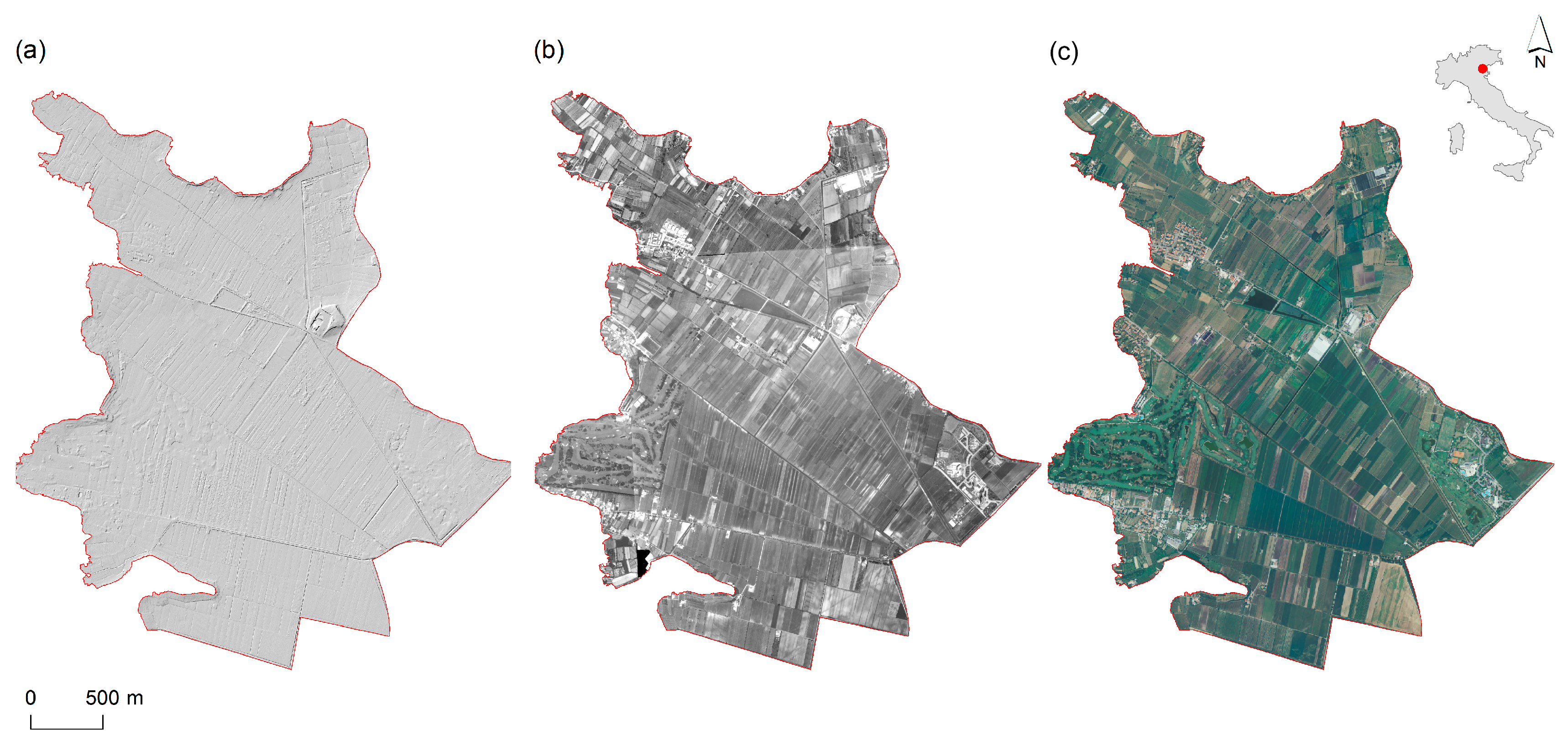
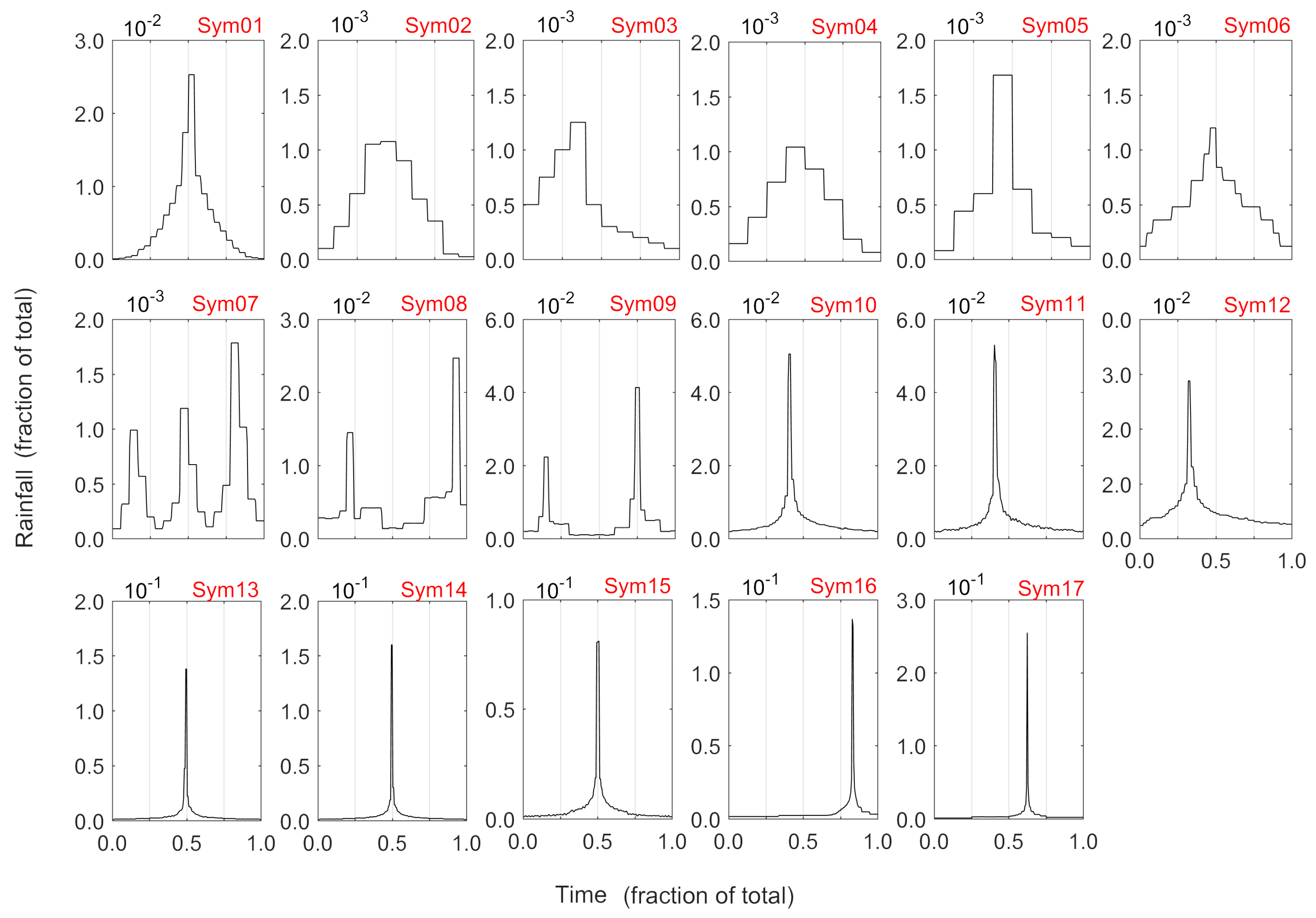
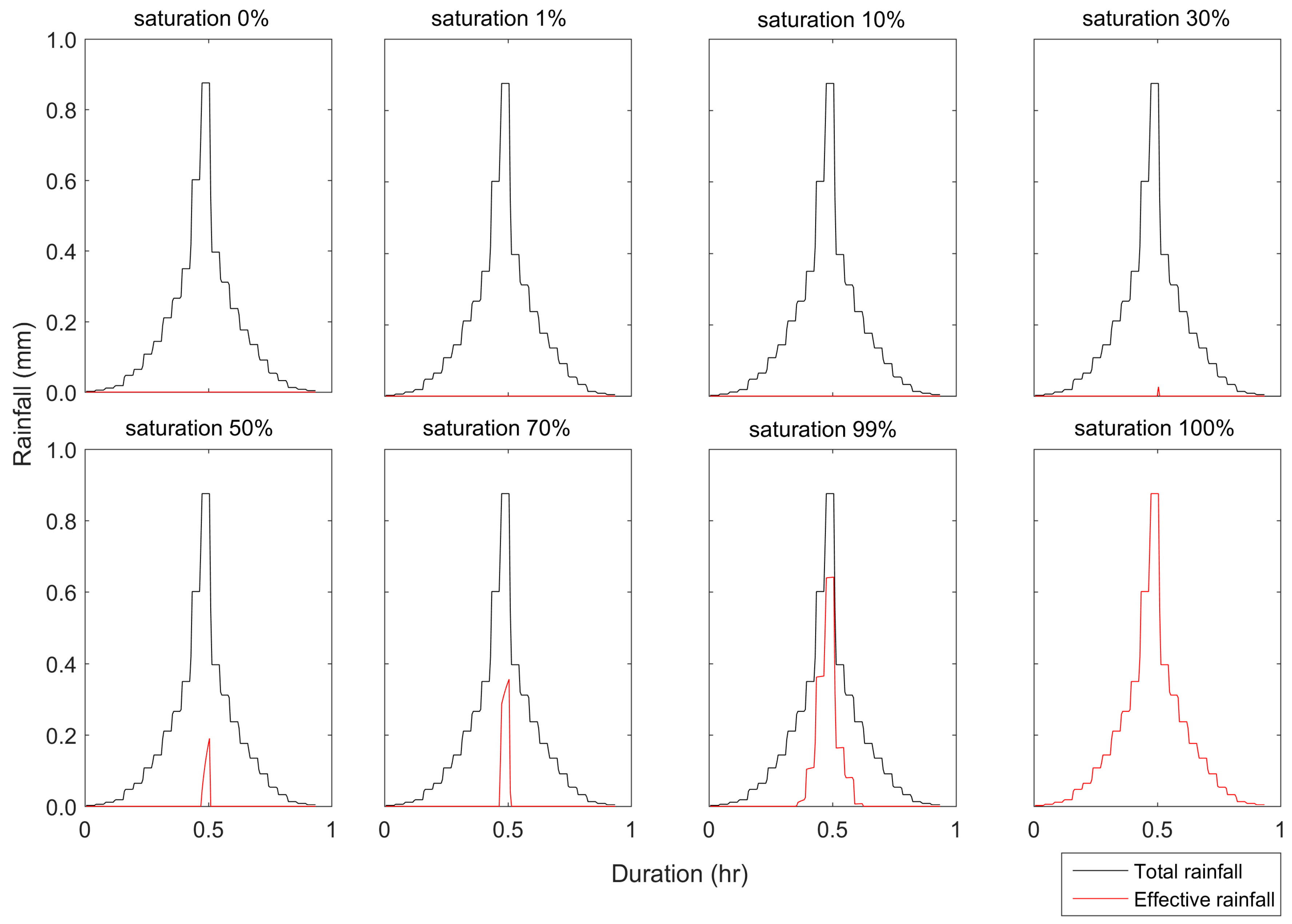

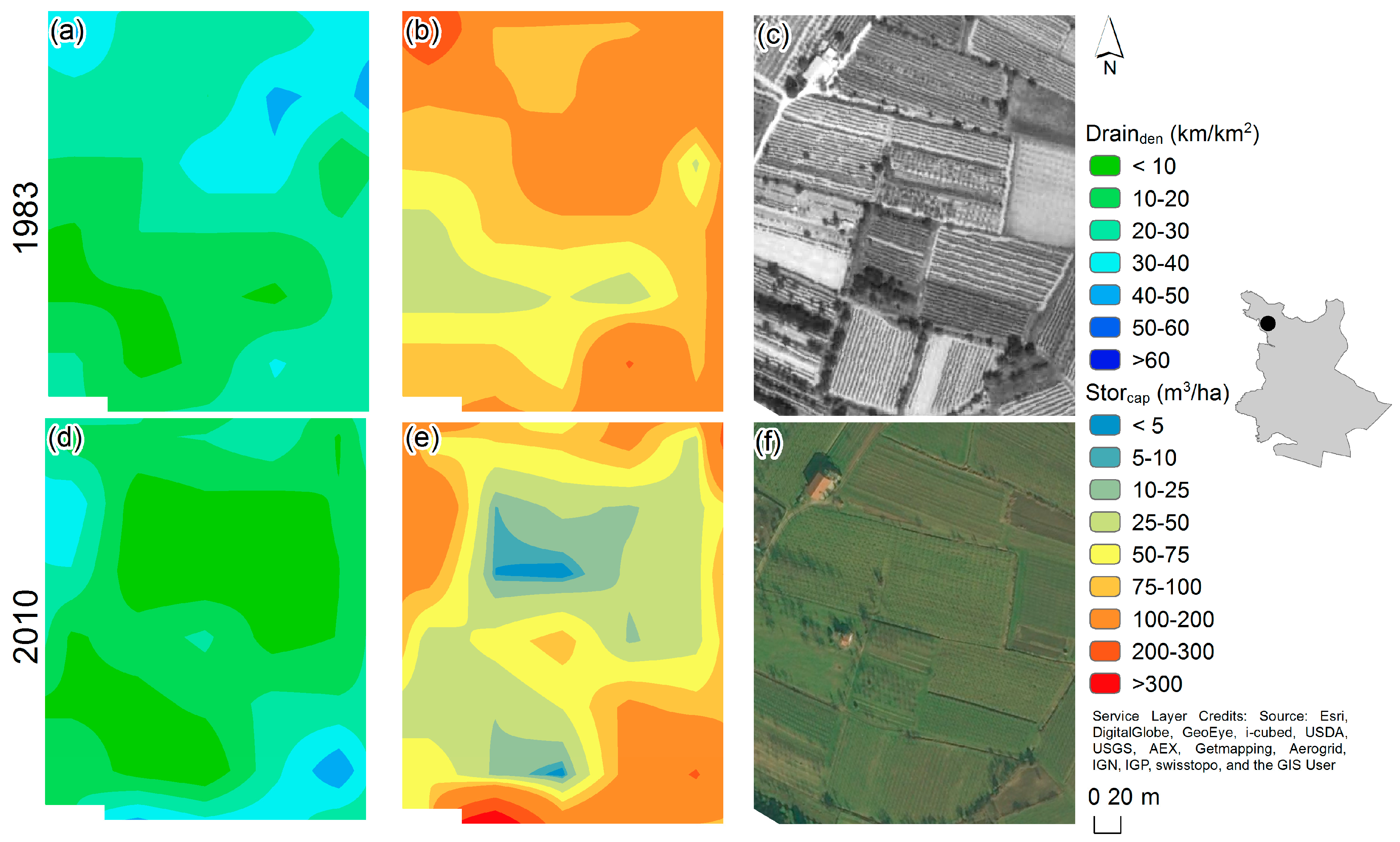



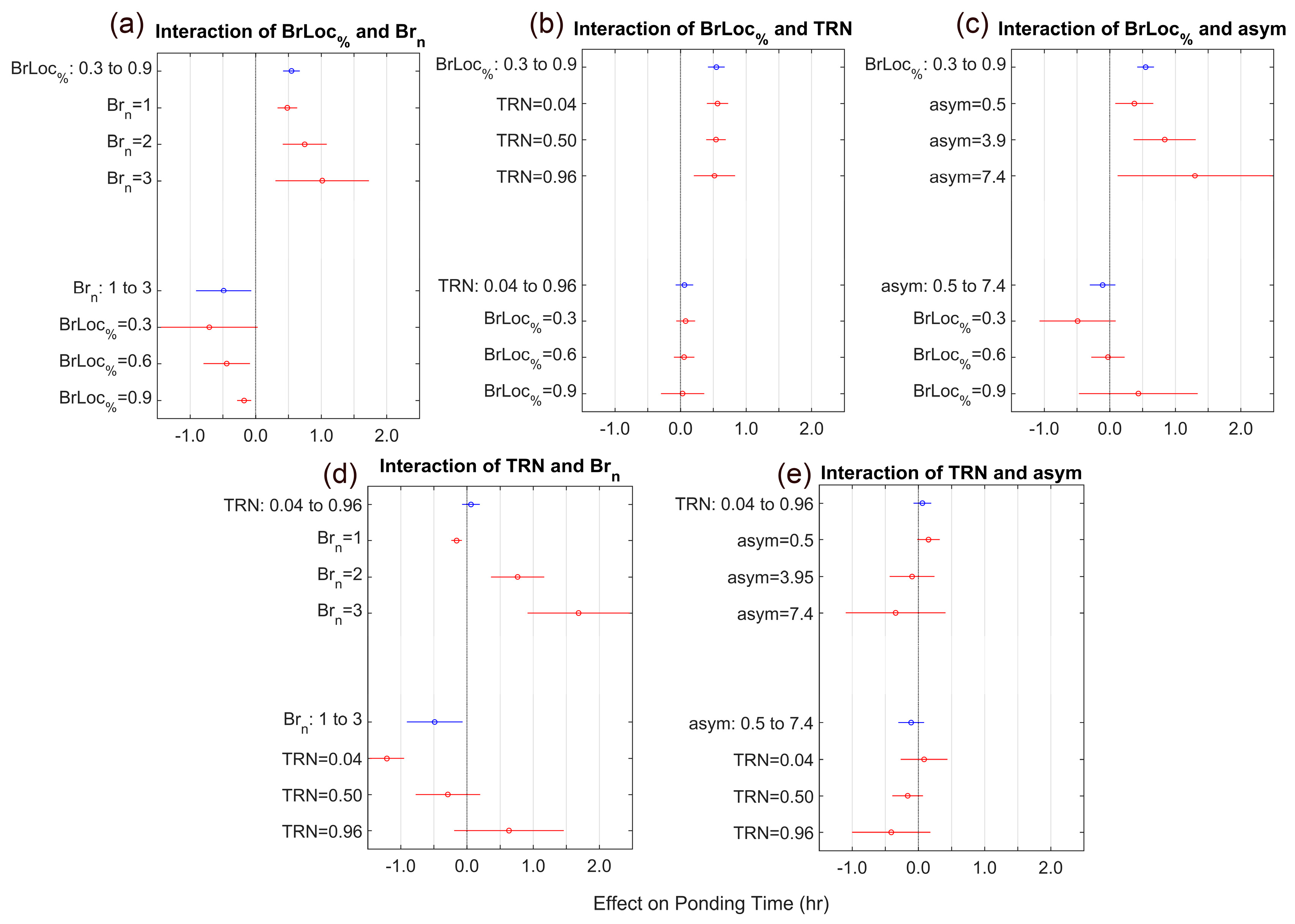
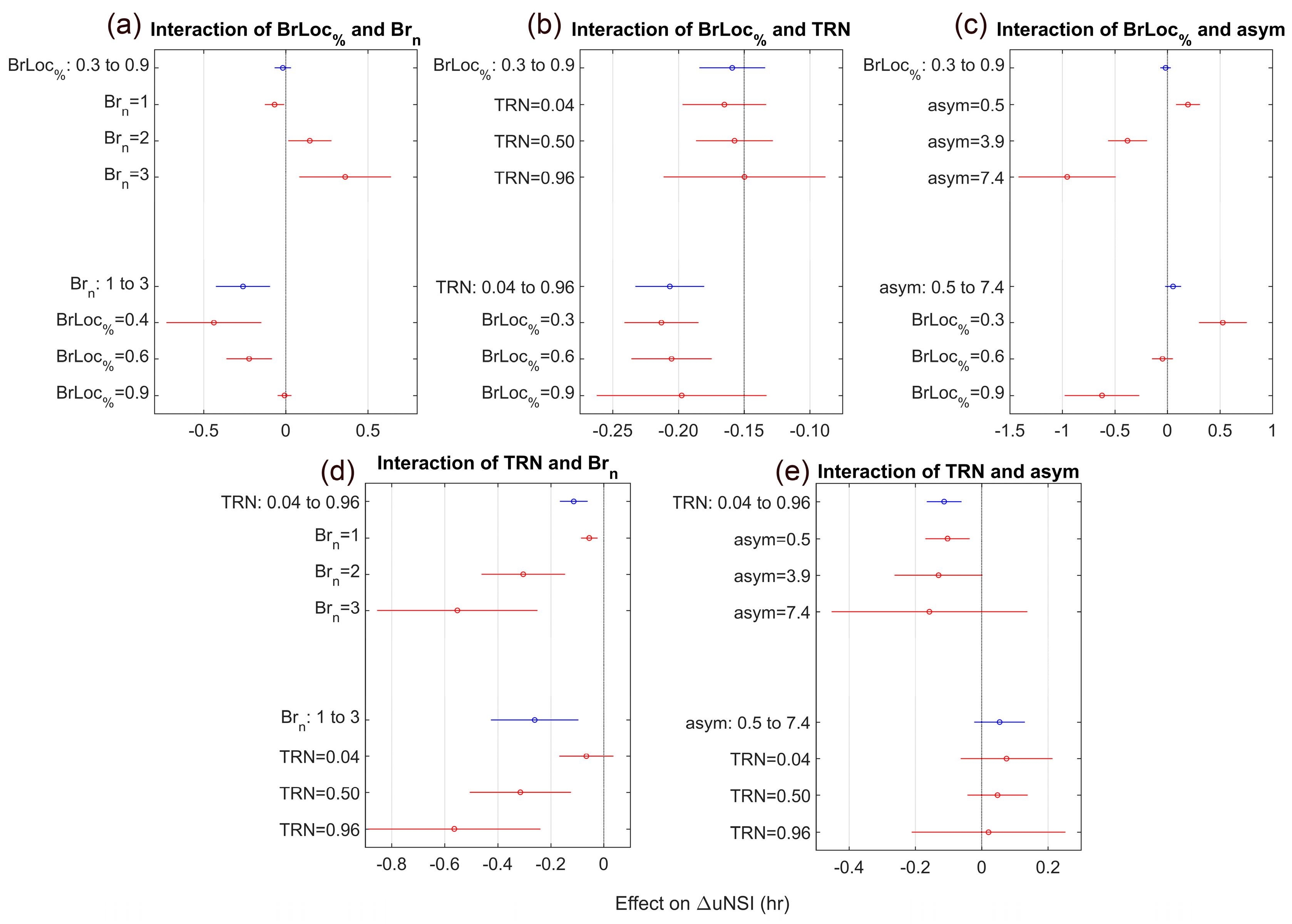
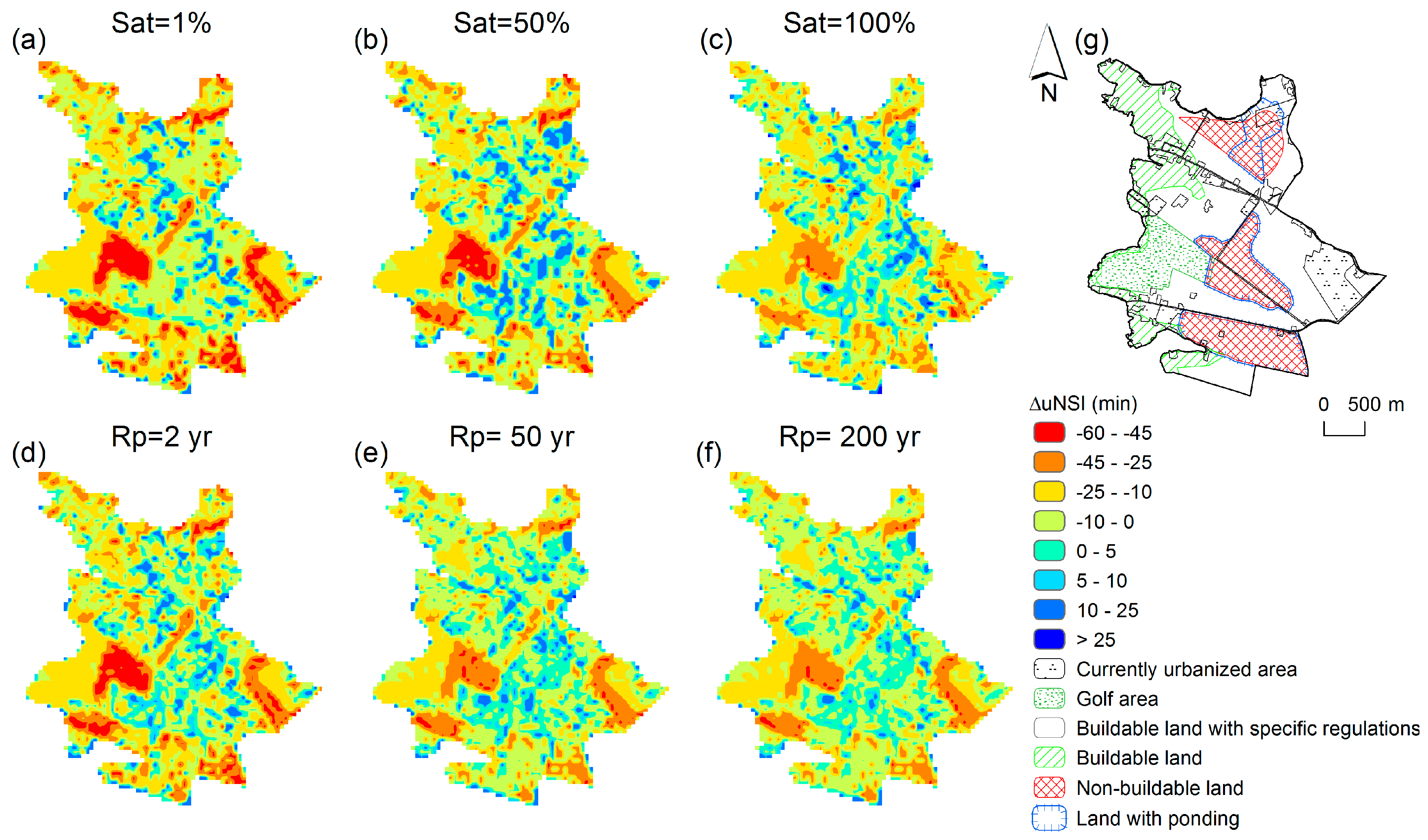
| Parameter | Value | |
|---|---|---|
| Effective hydraulic conductivity | Ks | 43.79 mm·h−1 |
| Matric pressure at the wetting front | Ψf | 130 mm |
| Saturated moisture content | θs | 0.63 |
| BrLoc% | Brn | TRN | Asym | |
|---|---|---|---|---|
| Sym01 | 0.5 | 1 | 0.4 | 1.8 |
| Sym02 | 0.5 | 1 | 0.9 | 1.5 |
| Sym03 | 0.4 | 1 | 0.8 | 1.5 |
| Sym04 | 0.5 | 1 | 1.0 | 1.3 |
| Sym05 | 0.4 | 1 | 0.6 | 1.0 |
| Sym06 | 0.5 | 1 | 0.8 | 0.9 |
| Sym07 | 0.8 | 3 | 0.6 | 3.0 |
| Sym08 | 0.9 | 2 | 0.4 | 7.4 |
| Sym09 | 0.8 | 2 | 0.2 | 2.1 |
| Sym10 | 0.4 | 1 | 0.2 | 0.6 |
| Sym11 | 0.4 | 1 | 0.2 | 0.6 |
| Sym12 | 0.3 | 1 | 0.3 | 0.5 |
| Sym13 | 0.5 | 1 | 0.1 | 1.1 |
| Sym14 | 0.5 | 1 | 0.1 | 1.6 |
| Sym15 | 0.5 | 1 | 0.1 | 1.9 |
| Sym16 | 0.8 | 1 | 0.1 | 1.8 |
| Sym17 | 0.6 | 1 | 0.0 | 1.7 |
| PT = f (Return Period) | PT = f (Saturation Condition) | |
|---|---|---|
| a | 0.37 (CI95 = 0.36, 0.39) | 0.52 (CI95 = 0.36, 0.68) |
| b | −6.29 × 10−4 (CI95 = −1.14 × 10−3, 1.18 × 10−4) | −0.83 (CI95 = −1.61, −0.04) |
| RMSE | 0.01 h | 0.1 h |
| R2 | 0.68 | 0.62 |
| ΔuNSI = f (Return period) | ΔuNSI = f (Saturation condition) | |
|---|---|---|
| a | −0.19 (CI95 = −0.21, −0.18) | −0.17 (CI95 = −0.18, −0.16) |
| b | −1.33 × 10−3 (CI95 = −1.23 × 10−3, 3.37 × 10−4) | −0.15 (CI95 = −0.19, −0.11) |
| RMSE | 0.01 h | 0.003 h |
| R2 | 0.72 | 0.92 |
© 2017 by the authors. Licensee MDPI, Basel, Switzerland. This article is an open access article distributed under the terms and conditions of the Creative Commons Attribution (CC BY) license ( http://creativecommons.org/licenses/by/4.0/).
Share and Cite
Sofia, G.; Tarolli, P. Hydrological Response to ~30 years of Agricultural Surface Water Management. Land 2017, 6, 3. https://doi.org/10.3390/land6010003
Sofia G, Tarolli P. Hydrological Response to ~30 years of Agricultural Surface Water Management. Land. 2017; 6(1):3. https://doi.org/10.3390/land6010003
Chicago/Turabian StyleSofia, Giulia, and Paolo Tarolli. 2017. "Hydrological Response to ~30 years of Agricultural Surface Water Management" Land 6, no. 1: 3. https://doi.org/10.3390/land6010003







